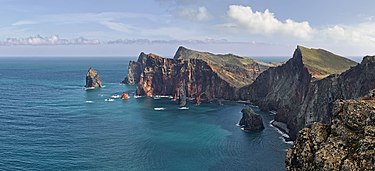Ponta de São Lourenço
Ponta de São Lourenço | |
|---|---|
 Ponta de São Lourenço from the vicinity of Machico | |
| Coordinates: 32°44′45″N 16°42′40″W / 32.74583°N 16.71111°W | |
| Location | Eastern Madeira Island |
| Part of | Machico Municipality |
| Offshore water bodies | Atlantic Ocean |
Ponta de São Lourenço (Portuguese for the "Point of Saint Lawrence") is the easternmost point of the island of Madeira. It is inside the town of Caniçal and forms a part of the municipality of Machico. Its terrain are made up of rocks and herbaceous vegetation. Since 1982, the headland is a nature reserve, where it has the conservation of its endemic plants including Matthiola maderensis, Echium nervosum, and Andryala glandulosa, and it has fauna, including birds, insects, and molluscs. One of them is Monachus monachus, a seal.[1] Marine fauna are in the waters surrounding the headland.

Northeast of the islet is Porto Santo, and southeast is Bugio and the Deserted Islands. Nearby are a few islets with the easternmost being Ilhéu do Farol (Farol Islet), where its nearby lighthouse is located.
The headland's highest point is Pico do Furado. The headland has a pathway which takes about an hour to reach from the headland entrance.
West of the headland is the New Port of Madeira.
Its geology consists of pyroclastic rocks as well as basalt dykes (dikes) and some coasts being eroded. The group dates back to the Late Pleistocene, about 100,000 years ago.[2]
References
- ^ http://natura2000.eea.europa.eu/Natura2000/SDF.aspx?site=PTMAD0003
- ^ "A Geological tour of the Archipelago of Madeira", Maria Luisa Ribeiro Miguel, Magalhães Ramalho, Direcção Regional do Comércio, Indústria e Energia Laboratório Nacional de Energia e Geologia, p 37 and 75
External links
 Media related to Ponta de São Lourenço at Wikimedia Commons
Media related to Ponta de São Lourenço at Wikimedia Commons

